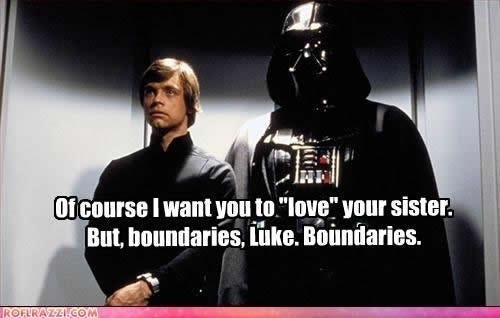Lure Of The Ring

With the recent release of the billion-dollar-grossing, fanservice-providing, feminist-friendly, Adam-Driver-showcasing, adequately-reheated Episode VII: The Force Awakens, the utterly abysmal Star Wars prequels have come in for a fresh round of vicious criticism from the pathetic nerds of the "SW Universe." (NB: that group includes your humble author.) It's now plainly apparent to everyone just how easy it would have been to make prequels that the audience actually liked and enjoyed, which is making everyone even more furious with George Lucas than they were previously. There's even a growing movement calling on Disney to remake the prequels and effectively erase "The Phantom Menace" et al from history the way Sebastian Shaw's ghost was digitally erased from the current distribution of ROTJ.
But what if we're all wrong about the prequels? What if we were to find out that they were brilliantly-planned-and-executed critical masterpieces that reinforced the Star Wars universe instead of copiously vomiting all over it? That is the argument made by a brilliant amateur critic in a website devoted to the "Star Wars Ring Theory", and whether you agree with him or not, his theory is also an object lesson on the true nature of literary and artistic criticism... even if it's not quite the lesson he intended...

The website is Star Wars Ring Theory and it is subtitled "The Hidden Artistry Of The Prequels". The site's author, Mike Klimo, argues that the prequels aren't the haphazard exercises in incompetent plotting, dismal acting, and cringe-worthy slapstick that most people have long believed them to be. Instead, he suggests that they form a "narrative ring" with the Original Trilogy that strengthens and deepens the story of the first three films.
If you read the whole site, as I did, you will at least be convinced that George Lucas put a lot more thought into the prequels than I had ever suspected. Over the course of what has to be eight thousand words or so, Mr. Klimo documents dozens of instances where Episodes I-II-III mesh perfectly with IV-V-VI. He offers compelling evidence that the prequels had to be the way they were in order to serve the story, all the way down to the oft-derided "virgin birth" of Anakin Skywalker and the dreaded midi-chlorians. Not that knowing all of this will help you enjoy the films any more --- I will personally confess to not watching Episodes II or III since my initial theatrical viewing --- but it will, perhaps, give you a new respect for them.
Even if you don't give the proverbial tinker's damn about Star Wars, the Ring Theory website is fascinating because it is an example of strong competitive criticism. When I was but a teenager, my favorite professor, Dr. Edward Tomarken, told me something that I probably should have figured out some years before: that criticism is competition to the text as much as, or more than, it is comment on it.
This is something that we all inherently understand: who among us hasn't read and enjoyed one of the "parody reviews" of a product on Amazon in which we would otherwise have no interest? For a few years after the millennium, there were thousands of people out there who spent countless hours of their time writing parody reviews. It was a whole community. Even I participated, albeit after I'd bought the product in question and become a verified customer for it. The magnum opus of parody reviews is surely the DeliciousTacos "review" of a male-masturbation egg, but the genre is so pervasive that Amazon now devotes a section to it. Literary, artistic, or product criticism, at its best, can thoroughly surpass the text on which is based. If it is not superlative or even good, however, it can still become famous in its own right; the David E. Davis, Jr. "test" of the BMW 2002 was indistinguishable from advertising copy but it is still held up forty-five years later as an example of the finest possible automotive journalism. The modern equivalent of that article is probably the Basem Wasef Z06 semi-advertorial in WIRED that was recently selected as the "Best New Vehicle Review of 2015" by the Motor Press Guild; it's a very long and uncritical way to say ZOMG THE Z06 IS Z-AWESUMZ but it was well-received by the industry.
The text to which my dear professor was referring when he schooled me on the essential nature of criticism was Samuel Johnson's Lives Of The English Poets, a work that was slammed out by Johnson in his spare time strictly for the cash but which has come to underpin much of English literary criticism. As Wikipedia will helpfully tell you, Matthew Arnold called it "... [a] performance which is itself a piece of English literature of the first class." In some cases, as with the Life Of Savage, the subject survives in history primarily because of Johnson's work and not on his own merits. This is an example where Johnson, as a critic, competes directly with Savage, the poet, for the reader's attention --- and wins handily.
With its detailed, tireless assemblage of images, concepts, and conceits, the Star Wars Ring Theory is just as much an attempt to impress the reader with Mr. Klimo's own perceptiveness and intelligence as it is an attempt to rehabilitate the reputation of George Lucas as a filmmaker. In this respect, I believe it succeeds...
...but if the reader has been attentive thus far, he is no doubt wondering, "Isn't this very article an attempt on Jack's part to compete with, and perhaps demonstrate superior understanding to, Mr. Klimo and his website?" The answer is "of course it is." Thus endeth the lesson, and the blog post.

